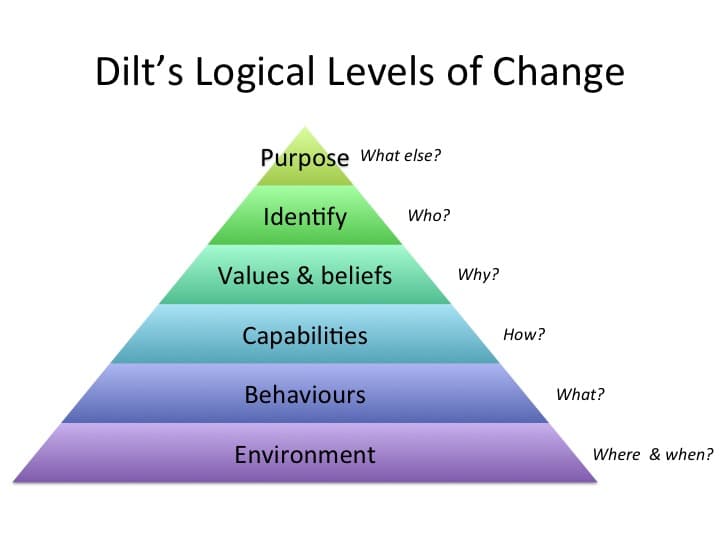Dilts' Pyramid: Levels of Thinking



Dilts' Logical Levels Pyramid
The Logical Levels Pyramid is a model developed by Robert Dilts, one of the leading experts in Neuro-Linguistic Programming (NLP). This concept helps to understand at which levels changes occur in a person’s life and what factors influence them.
To visualize the pyramid, imagine a triangle divided into six levels. Let’s explore each one, starting from the base.
Level 6: Environment
This level reflects the physical reality in which a person lives. It includes:
- Place of residence (city, country, home);
- Social environment (friends, family, colleagues);
- Work (industry, company, team);
- Financial status (income, assets, standard of living);
- Physical body (health, appearance, well-being).
People often want to change this level—improving living conditions, changing jobs, or surrounding themselves with new people. However, simply wishing for change is not enough—you need to change your behavior.
Level 5: Behavior
To change the environment, specific actions are required:
- Habits and daily routines;
- Ways of communicating with others;
- Reactions to events;
- Physical activity and self-discipline.
Example: If a person wants to move to a new city but takes no action, their dream remains just a dream. To achieve the desired outcome, they need to develop skills.
Level 4: Skills
Our actions are limited by our abilities. We cannot do what we haven’t learned. This level includes:
- Professional competencies;
- Communication skills;
- Self-organization;
- Emotional intelligence.
Example: If someone wants to earn more but lacks the necessary knowledge, they need to develop professional skills—learn a new profession or upgrade their qualifications.
But what drives us to learn? Our values and beliefs.
Level 3: Values and Beliefs
This level represents our internal guidelines:
- What is important to us in life?
- What do we consider possible or impossible?
- What beliefs shape our decisions?
Example: If a person values financial freedom, they will strive to develop skills that help them earn more. However, if they hold limiting beliefs such as "I'm not smart enough" or "I will fail," they won’t even try.
Here, it is crucial to work on limiting beliefs, replace negative thoughts with positive ones, and consciously form a strong value system. This shapes identity.
Level 2: Identity
Identity is our self-perception—the answer to the question: “Who am I?”
If a person sees themselves as lazy and unsuccessful, their behavior will reinforce this identity. If they see themselves as determined and successful, they will act accordingly.
Example: An athlete who says, "I am a winner," will strive for success regardless of circumstances. Their beliefs, skills, and actions will align with their goal.
But there is one more level that gives meaning to the entire pyramid.
Level 1: Mission (Spirituality)
At the top of the pyramid is the level of meaning—understanding one’s purpose, role in the world, and higher goals.
Questions at this level:
- Why do I live?
- What value do I create?
- What legacy will I leave behind?
Example: Successful entrepreneurs and leaders are often driven not by money but by an idea—to change the world, help people, or create something meaningful. This level provides powerful motivation and determines the direction of life.
How to Apply Dilts’ Pyramid?
If you want changes in life, start from the upper levels:
- Understand your mission.
- Define the identity you need.
- Examine your values and beliefs.
- Develop the necessary skills.
- Start taking new actions.
- As a result, your environment will change.
By applying this method, you can not only solve current problems but also transform your life on a deep level. 🚀





